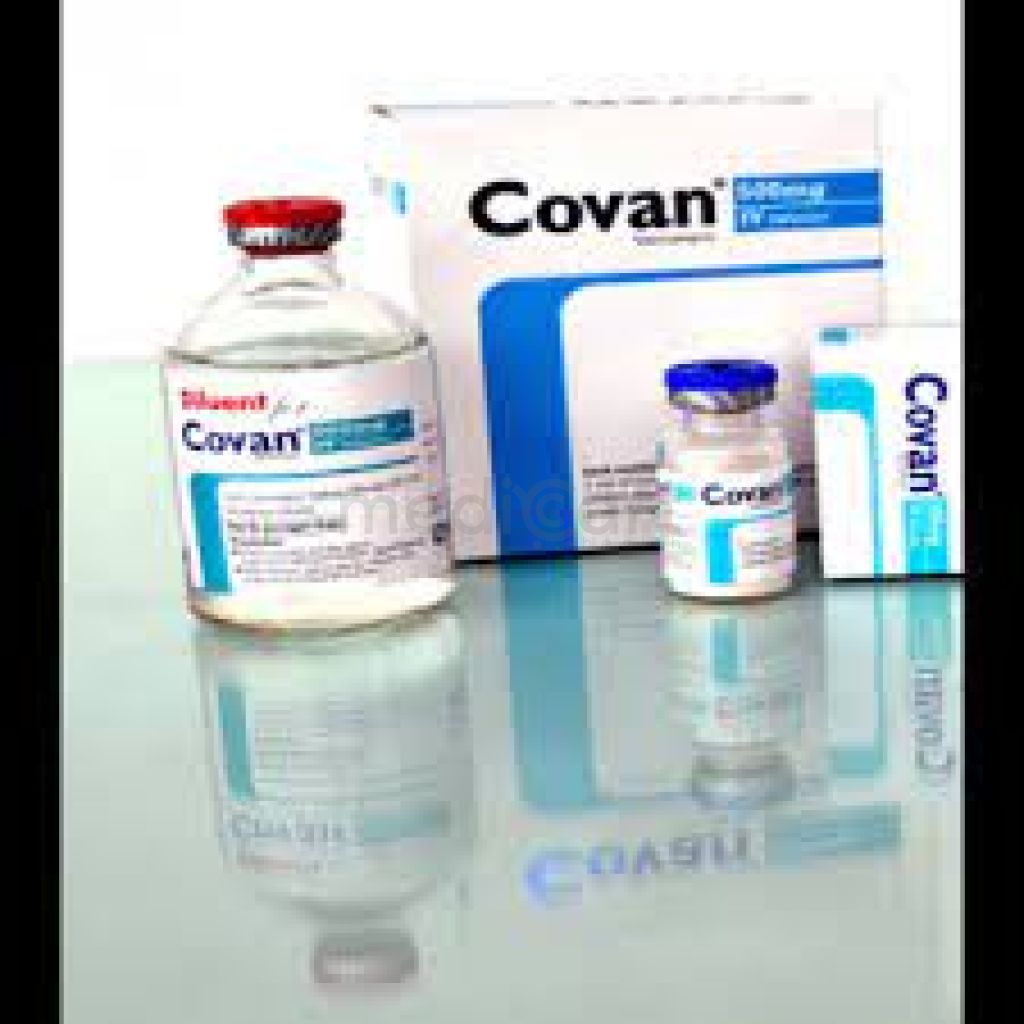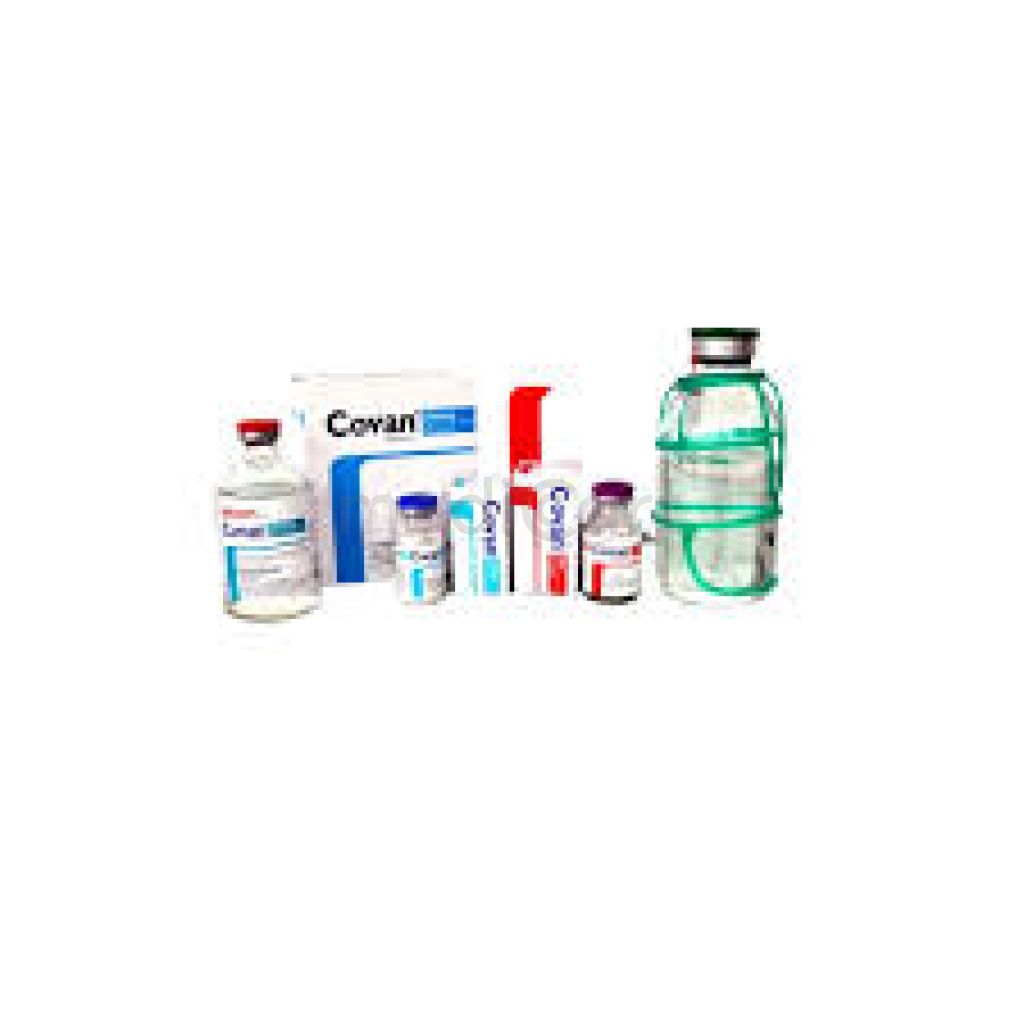

Covan 500mg
Injection
Pack Size :
1 Bottle x 1 Packet
Generics :
Vancomycin
Manufacturer :
Renata Limited
Best Price *
TK
250.00
* Delivery will be done in Dhaka city only.
More Information About - Covan 500mg
Description
Generic Name
VancomycinPrecaution
Patient w/ allergic reaction to teicoplanin, previous hearing loss, inflammatory bowel disease. Renal impairment. Elderly. Pregnancy and lactation. Monitoring Parameters Determine regularly serial tests of auditory function and serum or blood vancomycin concentrations during treatment. Periodic urinalysis and renal function tests. Monitor leukocyte count in prolonged therapy. Lactation: Drug enters breast milk; not recommendedIndication
Septicaemia, Soft tissue infections, Osteomyelitis, Enterocolitis, Colitis, Serious staphylococcal or other Gm +ve infections, Bacterial endocarditisContra Indication
Hypersensitivity to the drug; history of impaired hearing; IM administration.Dose
N/ASide Effect
>10% Erythematous rash on face and upper body (red neck or red man syndrome; related to infusion rate),Hypotension accompanied by flushing 1-10% Chills,Drug fever,Eosinophilia,Rash,Reversible neutropenia,Phlebitis <1% Nephrotoxicity,Ototoxicity (especially with large doses),Stevens-Johnson syndrome,Thrombocytopenia,Vasculitis Potentially Fatal: Stevens-Johnson syndrome; toxic epidermal necrolysis, blood dyscrasias such as neutropenia or thrombocytopenia.Pregnancy Category
Name : Not Classified
Description
FDA has not yet classified the drug into a specified pregnancy category.Mode of Action
Vancomycin binds tightly to D-alanyl-D-alanine portion cell wall precursor causing blockage of glycopeptide polymerisation which produces immediate inhibition of cell wall synthesis and secondary damage to the cytoplasmic membrane.Interaction
General anaesth may enhance the adverse effects of vancomycin. Increased risk of ototoxicity and nephrotoxicity w/ aminoglycosides, polymyxins, ciclosporin, cisplatin and loop diuretics. Increased potential of neuromuscular blockade w/ suxamethonium or vecuronium.Pregnancy Category Note
Pregnancy Animal reproduction studies have not been conducted with vancomycin Unknown whether vancomycin can affect reproduction capacity In a controlled clinical study, potential ototoxic and nephrotoxic effects of vancomycin on infants were evaluated when administered to pregnant women for serious staphylococcal infections complicating IV drug abuse Single-dose flexible bags only This formulation is not recommended for use during pregnancy because it contains the excipients, PEG 400 and NADA, which caused fetal malformations in animal reproduction studies (see Contraindications) Perform a pregnancy test in females of reproductive potential prior to prescribing this formulation Lactation Vancomycin is excreted in human milk Exercise caution when vancomycin is administered to a nursing woman Because of the potential for adverse events, a decision should be made whether to discontinue nursing or to discontinue the drug, taking into account the importance of the drug to the motherAdult Dose
Intravenous Severe staphylococcal or other Gram-positive infections, Endocarditis Adult: 500 mg 6 hrly, infused over at least 60 min or 1 g 12 hrly, infused over at least 100 min. Elderly: Dosage adjustment needed.Child Dose
Intravenous Children Severe staphylococcal or other Gram-positive infections, Endocarditis <1 month: 15 mg/kg followed by 10 mg/kg IV q12hr for neonates in first week of life and q8hr thereafter up to 1 month of age; longer dosing intervals recommended in premature infants >1 month: 10 mg/kg/day IV divided q6hr; individual dose not to exceed 1 gRenal Dose
Renal impairment: Patient on intermittent haemodialysis: Loading dose: 15-25 mg/kg on day 1, followed by 5-10 mg/kg maintenance dose after each dialysis run. Anuric patient (w/o kidney function) on dialysis: Initially, 15 mg/kg. Maintenance: 1.9 mg/kg 24 hrly. CrCl (ml/min) Dosage Recommendation <20 Longer intervals; determine by serum concentration monitoring. 20-49 Initially, 15-20 mg/kg/dose (usual: 750-1,500 mg) 24 hrly. >50 Initially, 15-20 mg/kg/dose (usual: 750-1,500 mg) 8-12 hrly.Administration
IV Preparation Add 10 mL of SWI to 500-mg vial and 20 mL of SWI to 1-g vial to yield 50 mg/mL solution; further dilution is required, depending on method of administration Intermittent infusion: Dilute 500 mg with ?100 mL of diluent and 1 g with ?200 mL of diluent (NS or D5W) Continuous infusion: Dilute in sufficient amount to permit infusion over 24 hours IV Administration Intermittent (preferred): Administer over 60 minutes; not to exceed 10 mg/min Continuous: Administer over 24 hoursDisclaimer
The information provided herein are for informational purposes only and not intended to be a substitute for professional medical advice, diagnosis, or treatment. Please note that this information should not be treated as a replacement for physical medical consultation or advice. Great effort has been placed to provide accurate and comprehensive data. However, Medicart along with its authors and editors make no representations or warranties and specifically disclaim all liability for any medical information provided on the site. The absence of any information and/or warning to any drug shall not be considered and assumed as an implied assurance of the Company.




